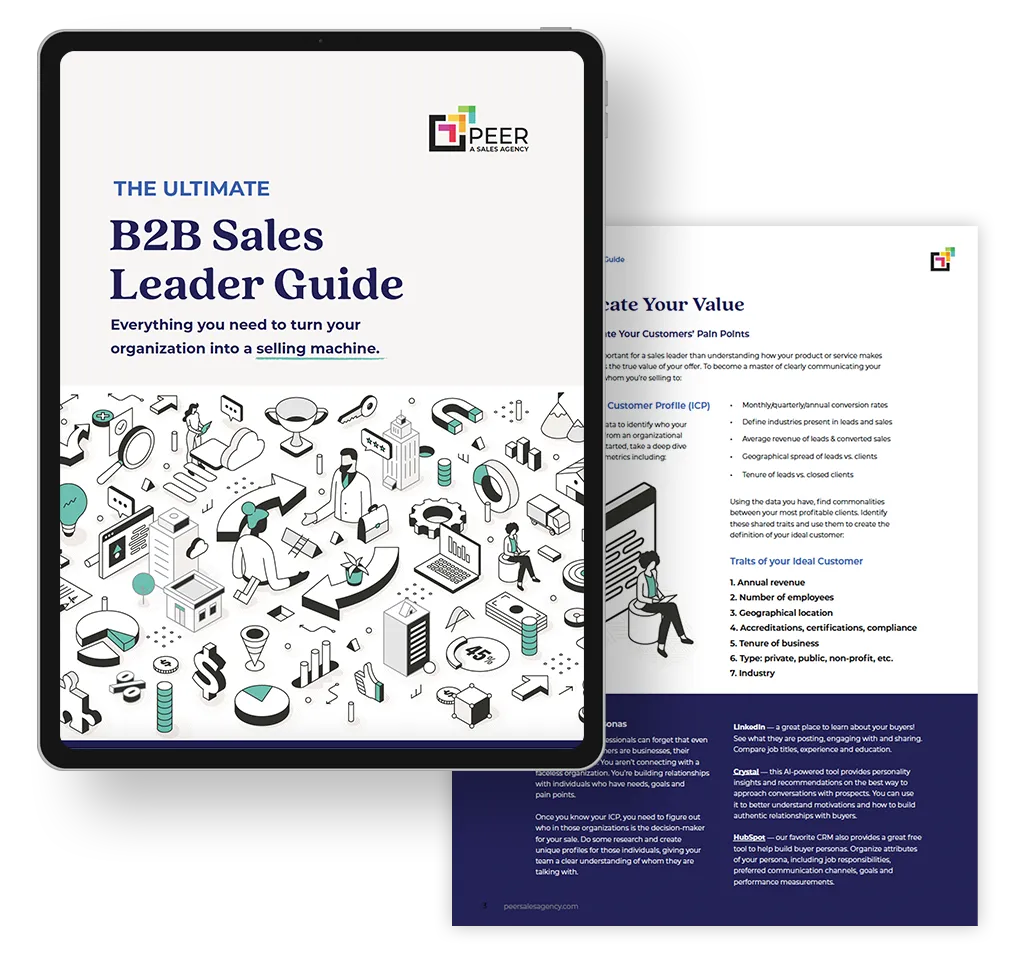If you’re a B2B sales leader struggling to convert those leads, you’re not alone. One key milestone in the sales pipeline that can make or break a sale is the Marketing-to-Sales handoff. This is where your marketing team hands over the leads they’ve generated to your sales reps, so they can work their magic and turn those leads into paying customers.
Now, why is this handoff so important? Well, it’s a crucial point in the customer journey because it’s where the real selling begins. The leads that have been generated by the marketing team are now in the hands of your sales team, and it’s their job to nurture those leads and guide them through the sales process.
But here’s the thing – this handoff can be a bit tricky. Challenges often come up during this phase of the sales process, such as miscommunication between teams, differing expectations, and even a lack of follow-through. If you’re not focusing on this important process, it can seriously reduce your closing rates.
In short, the Marketing-to-Sales handoff is a critical step in the customer journey, and if you’re not paying attention to it, you could be missing out on valuable opportunities to grow your business.
Sales and Marketing Alignment During Lead Handoff
Here’s a secret: the key to success lies in the collaboration between your sales and marketing teams. It seems so simple, yet is so elusive.
First things first, let’s talk about the handoff process. The first step to streamline this whole deal is to have a sit-down conversation between your sales reps and the marketing department. I’m talking about a serious discussion that leads to alignment and agreement.
Why is this collaboration so crucial? Think about it – your marketing team is out there generating top-of-funnel leads like it’s their job. Because, well, it is. But if the most promising of those leads aren’t getting to your sales team in an actionable way, you’re basically throwing money down the drain.
By getting everyone on the same page, you can ensure that your sales team knows exactly what the marketing team has been up to. And vice versa. It’s a beautiful thing, really.
So, get those two teams talking. Encourage them to share insights, goals, and strategies. Let’s make this handoff process as smooth as silk, shall we?
Agree on What a Great Lead Looks Like
Before you can start converting, you need to make sure you’re targeting the right people in the first place. That’s where having a well-defined Ideal Customer Profile and strong buyer personas come into play.
It’s crucial that both your marketing and sales teams are on the same page when it comes to the characteristics of viable leads. If you’re not aligned, you’ll end up chasing after the wrong types of leads, and that’s just a waste of time and resources.
So, how do you get everyone on the same page? Start by asking some key questions that both teams can agree on. For example:
- What industries are our ideal customers in?
- What are their pain points and challenges?
- What job titles do they typically hold?
- What are their key buying motivations?
By getting sales and marketing alignment on the answers to these questions, you’ll be well on your way to targeting the right leads and converting them into loyal customers. Keep these points in mind, and you’ll be on the path to growth in no time!
Reverse Engineer Your Ideal Lead
One way to really lock in on the right leads is to sit down with your sales team and reverse engineer their ideal lead. Here’s how to do it:
- Get your sales team together and have them describe their dream lead. What does this company look like? What pain points are they experiencing that your product or service can solve? What’s their budget like? The more specific, the better.
- Next, work backward from there. What traits and characteristics does the ideal lead have? Start crafting a profile based on these traits. This will help you and your team know exactly what to look for when generating leads.
- Once you have a clear picture of your ideal lead, use this profile to guide your marketing efforts. Tailor your messaging and targeting to attract leads from marketing that match this profile.
By understanding what your sales team wants in a lead and working backward to create a clear profile, you’ll be able to better target and convert the right leads for your business.
How Lead Scoring Can Help
Lead scoring takes the guesswork out of the lead qualification process. No more relying on gut feelings or subjective opinions on what is or isn’t a sales opportunity. With lead scoring, you can objectively evaluate each lead based on specific criteria and assign them a score that reflects their potential.
One of the best things about lead scoring is the transparency it brings to the handoff process. When your marketing team passes a lead to your sales team, there’s no confusion about whether it’s ready to be contacted. The score tells you everything you need to know.
So, what attributes can you use for lead scoring? Here are a few examples:
- Demographics: Are they in your target industry, company size, or budget fit?
- Behavior: Have they engaged with your content or visited your pricing page?
- Persona Fit: Do they have the seniority and authority to make a purchase decision?
With lead scoring, you can focus your efforts on the leads that matter most. No more wasted time on dead-end leads.
Defining MQL
A marketing qualified lead (MQL) is a lead who has shown interest in your products or services and is more likely to become a customer compared to other leads. These leads have been deemed worthy of your sales team’s time and effort because they have engaged with your marketing activities in a meaningful way.
Now, how do you identify these MQLs? You need to look at two important factors: Ideal Customer Profile (ICP) fit and opt-in activities.
ICP fit means the lead matches the characteristics of your ideal customer. This includes things like industry, company size, and job title. Opt-in activities refer to the actions a lead has taken to show interest, such as downloading a whitepaper or attending a webinar.
By focusing on these two factors, you can pinpoint those MQLs and put your efforts where they count.
Defining SQL
So, let’s talk about sales-qualified leads. What the heck does that even mean? Well, it’s pretty simple. A sales-qualified lead (SQL) is a potential customer your sales team has identified as ready to purchase. In other words, they’re not just kicking tires – they’re serious about buying.
Now, how do you know if a lead is ready to close a deal? Look for high-intent behaviors and activities. These are the signs that someone is itching to buy. Things like:
- Requesting a demo or a quote
- Downloading a product comparison
- Signing up for a free trial
- Asking for pricing information
When you see these kinds of actions, you know you’re dealing with an SQL. They’re not just browsing – they’re actively looking for more info because they’re ready to make a decision.
From Marketing Qualified Lead to Sales Qualified Lead (and Back)
The journey from Marketing Qualified Lead (MQL) to Sales Qualified Lead (SQL) can be a challenging road. Sometimes, a lead might seem like a slam dunk MQL, but when they get passed on to the sales team, it turns out they’re not quite ready to make a purchase.
This is where the fun part comes in – the back and forth between marketing and sales. You might have to send that SQL back to the marketing team for some extra nurturing. It’s like a little boomerang of potential business.
So, what can you do to make sure this transition is as smooth and successful as possible? Here are a few tips:
- Keep the lines of communication open between marketing and sales so they can collaborate on lead nurturing.
- Ensure that your marketing team knows exactly what kind of leads the sales team is looking for.
- Implement a lead scoring system to help determine the readiness of a lead to make a purchase.
- Don’t be afraid to send an SQL back for more nurturing if necessary. It’s all part of the game.
With some teamwork and strategic thinking, you can ensure that those MQLs are turning into rock-solid SQLs and, ultimately, happy customers.
Analyze and Optimize Your Handoff Process
Like any milestone in the sales pipeline, you can’t just set it and forget it. Keep an eye on that handoff process and see where things might get stuck or fall through the cracks. There is nothing worse than losing a lead because of a bumpy handoff.
Be ready to adapt and change things up if something ain’t working. Maybe your sales team needs more information from the marketing folks, or maybe the timing of the handoff needs to be adjusted. Whatever it is, be nimble and ready to make some moves.
Make Sure to Measure Success
Key Performance Indicators (KPIs) are a crucial tool in evaluating the effectiveness of your marketing-to-sales handoff. You’ll want to keep an eye on metrics like:
- Conversion rates: How many leads are turning into sales?
- Sales cycle length: How long does it take from lead to sale?
- Lead response time: How quickly are you reaching out to new leads?
- Customer lifetime value: How much money are they spending with you over time?
And when it comes to customer data, you’ll need to align your CRM (Customer Relationship Management) platform with your marketing automation platform. By combining these tools, you’ll have better visibility into your customers’ behavior, preferences, and interactions with your business.
By tracking these KPIs and aligning your platforms, you’ll have a clearer picture of what’s working and what’s not. With that knowledge, you’ll be able to fine-tune your sales process and start turning those leads into satisfied customers.
Create a Feedback Loop to Improve the Process
This is a living, breathing process requiring constant attention from both sides.
Encourage sales and marketing to share information and insights regularly. This will help you identify any hiccups in the handoff process and make it smoother and more productive.
By checking in frequently, you can address any issues that arise in real time and prevent potential leads from growing cold. It’s all about being proactive and staying on top of every little detail. Plus, when everyone is on the same page, aligning your strategies and making the most of your efforts is easier.
Final Thoughts on the Marketing-to-Sales Handoff
Converting leads is all about communication and follow-up. Keep these key points in mind as you work on improving your lead conversion processes:
- Be prompt and pleasantly persistent in your follow-up. You can’t force someone to buy, but you can be there when they’re ready.
- Use multiple channels to reach out to leads, including phone, email, and social media.
- Personalize your interactions with leads to show that you value their business.
- Ensure your sales and marketing teams are aligned and working together towards the same goals.
- Track and analyze your lead conversion data to identify areas for improvement.
Remember, it’s not just about quantity – it’s about quality. Focus on nurturing and qualifying your leads, rather than just trying to push them through the sales funnel. Building genuine relationships with your leads will lead to better conversion rates and long-term customer satisfaction. If you’re interested in learning more about sales and marketing alignment, along with other sales enablement strategies, take a look at our Ultimate B2B Sales Leader Guide.



